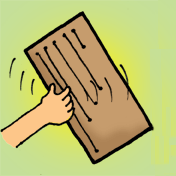
Do the Wave
[30 Minutes]
Music is everywhere! No matter how old you are, everyone likes some type of music. Did you know that science can help you understand how humans hear those wonderful sounds? Here’s a fun activity for you to do at home on a brisk winter day while you are indoors.
You'll need:
• one piece of smooth wood, at last 15” in length X 10” • 10 nails of the same length (1”) • 36” of nylon string (fishing line) • a hammer (ADULT ONLY) • scissors • pencil • ruler
What to do:
- If possible, print out these directions. Read them through with your child before you begin.
- With your child, gather everything you need.
- Help your child measure and mark five vertical dots down the left side of the shorter side of the piece of the wood, making them approximately 1” apart.
- With your child, cut the nylon string into five lengths: 6”, 8”, 10”, 1”, and 14”.
- While your child observes, hammer a nail into each of the five penciled dots.
- Let your child hand you the longest piece of nylon string and attach one end of the string to the top nail; continue with the other four, longest to shortest.
- Make a knot at the end of each piece of string, and slip a nail through the knot enabling it to be nailed at the far end of the wood; secure the nails in the wood.
- Ask your child to make sure the strings are as taut as they would be on a guitar.
- Help your child tighten the strings as necessary.
- Pluck each string and compare sounds.
Let's Talk: Ideas to Explore Together.
- Does each string make a different sound? What do they sound like?
- Which string makes the highest sound?
- What makes the difference in the sound produced by each string?
Useful information:
A sound wave is movement that travels through the air and is picked up by our ears as sound. When you see people at a ball game “doing the wave,” it looks very much like the sound wave traveling through the air to our ears. Sound waves can be small and move very fast, or they can be big and move quite slowly. Picture yourself throwing a stone in a lake. When the ripples of water circles spread through the water, it is very much like the ripple or “waves” of sound. When you made your instrument, you probably noticed that the longer the string was, the lower the sound, or pitch, seemed. This occurs because the longer string creates a slower vibration (movement). The movement or “waves” are wider and farther apart than when you pluck the shorter string, where it is quicker and closer together. Your funnel-shaped ear collects the sound waves that translate in your brain to the sounds you hear, depending upon how the air molecules have been sent to your ear.
|